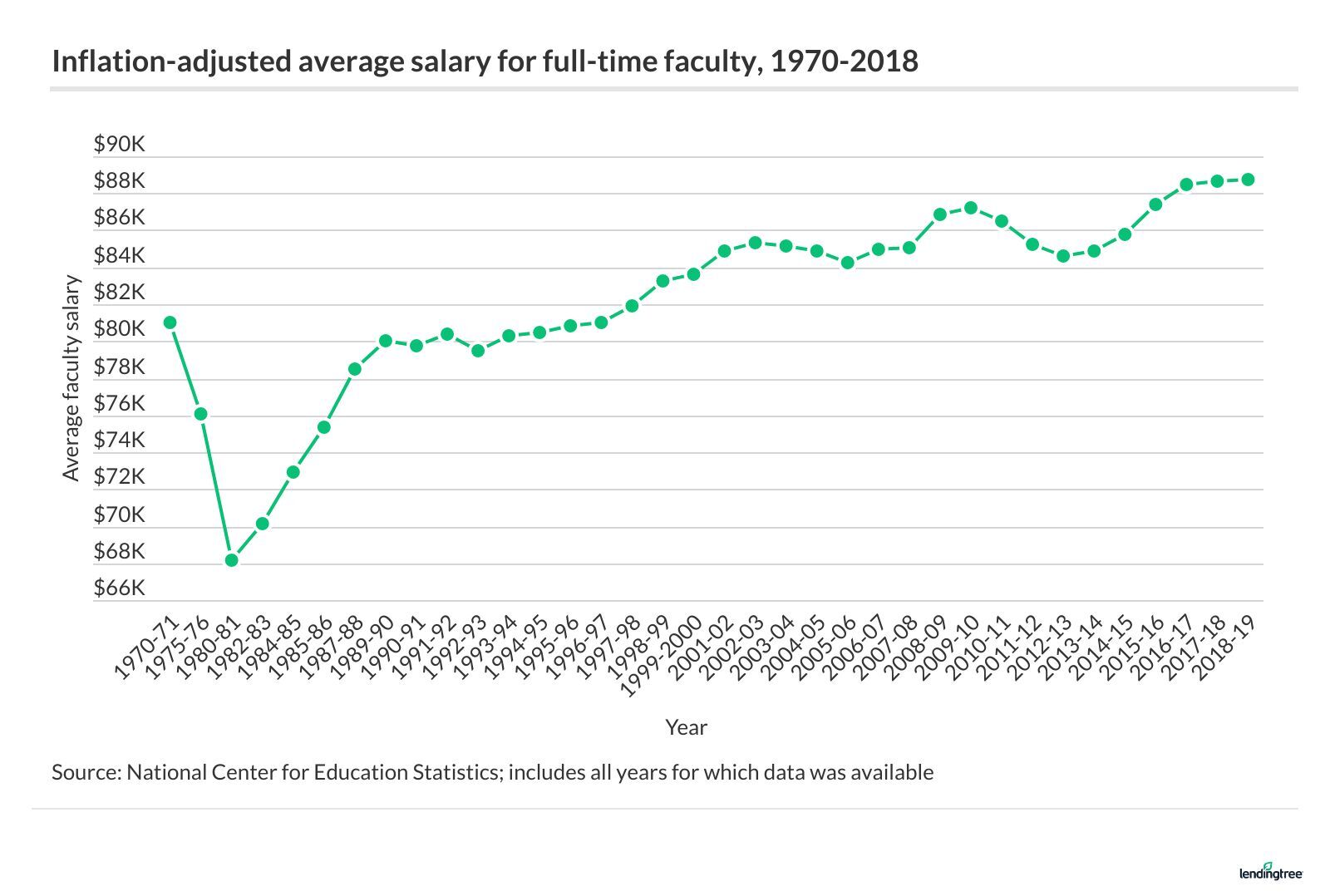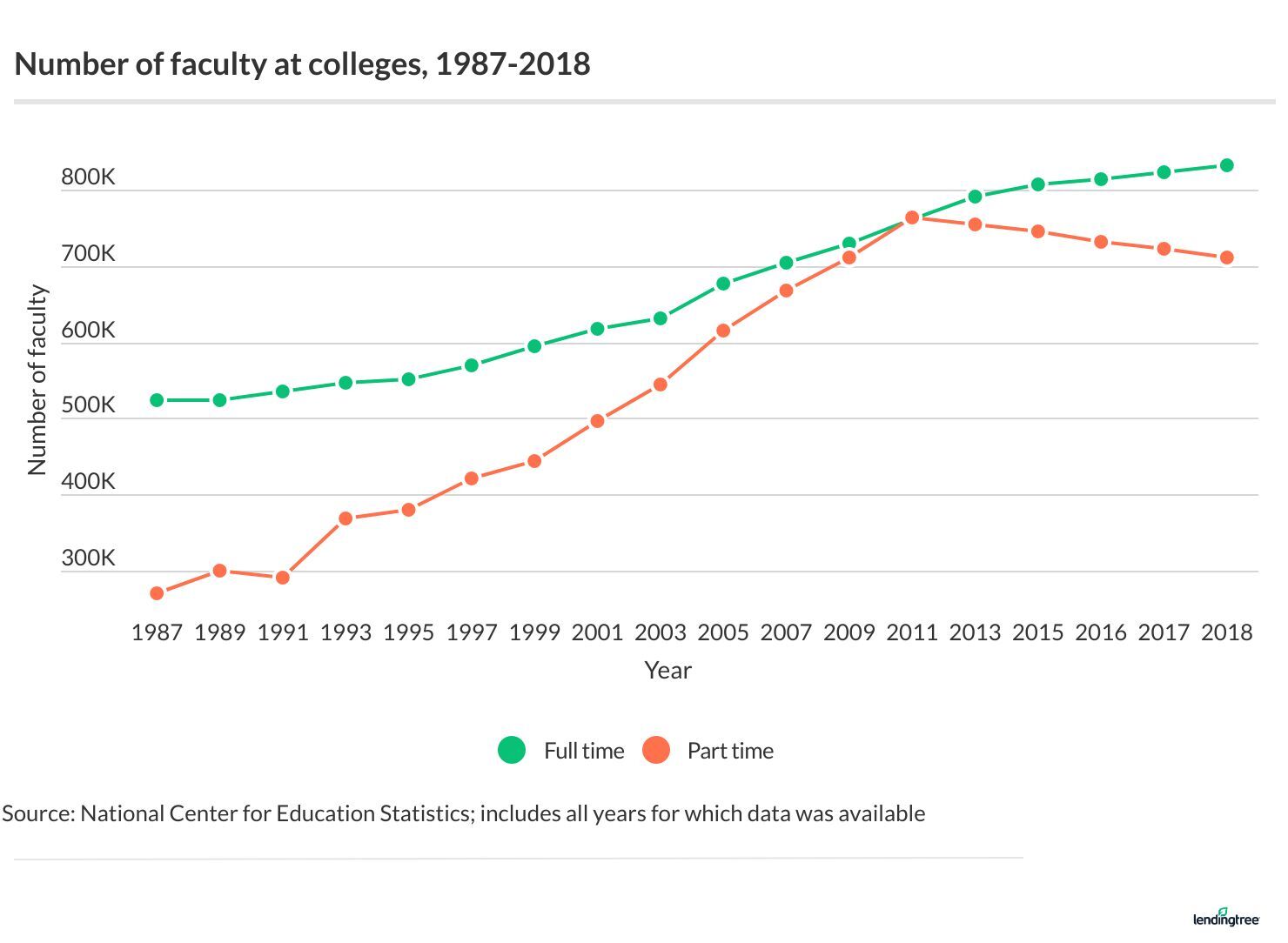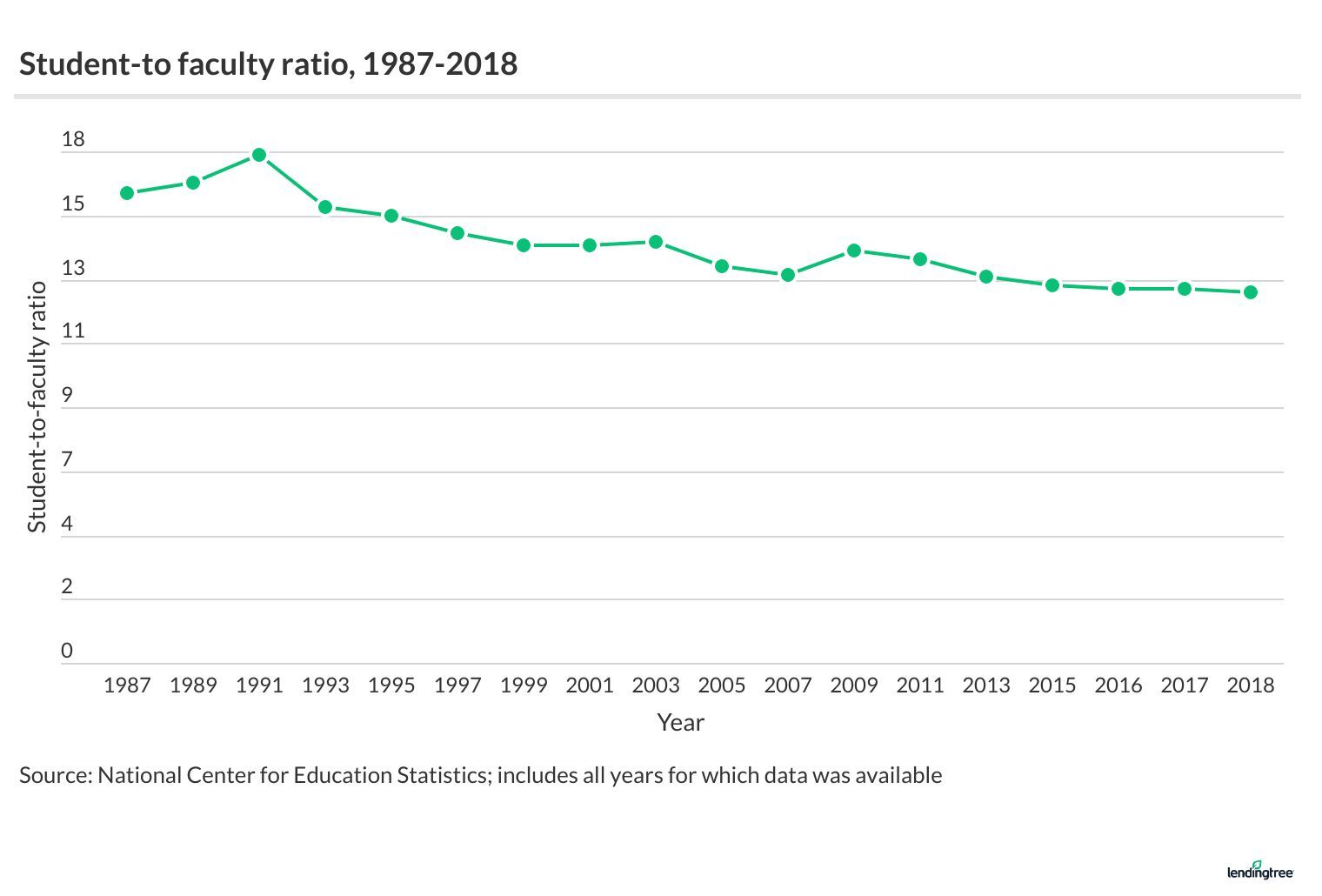Study: For Full-Time College Faculty, Inflation-Adjusted Salaries Up Only 9.5% Since 1970
College faculty across the country have had to rethink and adapt lectures and instruction for virtual learning amid the global coronavirus pandemic.
But faculty who think this may lead to substantial extra pay may be disappointed, given the historical context. As colleges have grown over the last half-century, less money has gone to faculty, according to a LendingTree analysis. This has occurred even as revenues — which were nearly $409 billion in the 2017-18 school year — have spiked.
Our researchers dug into historical faculty-pay data to give a glimpse at where things are headed. Here’s what we learned.
Key findings
- The average salary for full-time faculty — when accounting for inflation — has increased just 9.5% over nearly 50 years. In the 1970-71 school year, full-time faculty were paid the equivalent of $81,030 on average in 2018-19 dollars. By 2018-19, that figure had only risen to $88,703.
- Though salaries have remained relatively stagnant, full-time faculty at private institutions have seen a 30.9% increase since 1970-71. Faculty were paid the equivalent of $74,074 on average in 1970-71 after adjusting for inflation. By 2018-19, they earned an average of $96,962.
- Full-time faculty at public institutions have seen a 3.1% increase since 1970-71, from an average of $82,585 (when adjusted for inflation) to $85,148 in 2018-19.
- At the state level, faculty in the District of Columbia have seen the biggest average salary boost from 1994-95 (the earliest date available) to 2018-19. In the nation’s capital, faculty members saw their inflation-adjusted salaries rise by 25.1%. New Mexico — which saw pay fall by 3.9% on average in that period — ranked last.
How average salaries for full-time faculty have changed since 1970
There haven’t been significant changes to full-time faculty salaries since 1970 when accounting for inflation (about 4% per year). In fact, the average salary increases from 1970-71 to 2018-19 for full-time faculty were roughly equivalent with inflation:

There has been a shift in the average salaries for faculty at public and private institutions over this period. Accounting for inflation, full-time faculty at public universities were paid more ($82,585) than faculty at private universities ($74,074) in 1970-71.
Since then, average salaries for private university faculty have risen by nearly $22,900, while average salaries for public university faculty have only risen about $2,600. That means private faculty earn about $11,800 more on average compared to their public counterparts.
And while faculty at public two- and four-year institutions generally earned the same average salaries in 1970-71, the gap has since widened to favor those at four-year institutions:
| Average salaries for full-time faculty at public 2-year and 4-year universities | ||
| Public 2-year school | Public 4-year school | |
| 1970-71 | $80,612 | $83,656 |
| 2018-19 | $70,404 | $89,641 |
| Source: National Center for Education Statistics; 1970-71 salaries account for inflation | ||
Over this period, lecturers have seen an overall decrease in earnings, going from the equivalent of $71,381 to $62,542.
Faculty salary increases by state, from the District of Columbia to New Mexico
Faculty in the Northeast have seen the largest percentage increase in average salaries since 1994-95 (the earliest date available), claiming five of the top 10 spots on this list:
Of the bottom 10 states on this list, half — New Mexico, Alaska, Wisconsin, Mississippi and Arkansas — saw decreases in faculty pay during the examined period. Four of the bottom 10 are in the South, followed closely by three each in the Midwest and West.
Full-time faculty facts, from numbers to ratios
- The percentage of full-time faculty fell from 77.8% in 1970 to 53.9% in 2018.

- Student-to-faculty ratios have lowered from 16.1 in 1987 to 12.7 in 2018. From 1987 to 2018, the number of students grew from 12,766,642 to 19,645,918, while the number of faculty increased from 793,070 to 1,542,613.

- The value of benefits packages increased by 92.3% when accounting for inflation, from $12,953 in 1977-78 to $24,909 in 2010-11 (the latest available data).
- In the 2009-10 school year, salaries and wages for instruction personnel made up 18.4% of the budget. By 2017-18, that figure was down to 16.9%.
3 tips for negotiating your salary
Negotiating your salary is often intimidating, and perhaps more so given the current climate. But with the right tactics, it can lead to success.
Figure out your market value
Understanding what’s normal for faculty in your position at similar institutions is a good start. This can be done by canvassing job postings and talking to your peers around the country.
“Openness among colleagues is especially critical, as increased transparency can help to close the gender pay gap,” said Andrew Pentis, LendingTree’s senior writer for student loans. “The more information you can gather about your value, the more leverage you’ll have at the negotiating table.”
Consider alternatives to a straight pay increase
Increasing your annual earnings is always a good thing, but it may be worth looking into boosting other parts of your compensation, such as student loan repayment assistance. This may lessen the salary increase, but it could still provide value — and peace of mind. Just because you’re a faculty member doesn’t mean you don’t have federal or private student loans of your own, so a different approach could be beneficial.
Make your case well
Having concrete information about your performance, including awards or positive reviews from colleagues and students, can provide valuable leverage in the raise discussion.
“We have decades of evidence pointing to the fact that many colleges and universities won’t volunteer to raise your pay to the right level,” Pentis said. “It’s incumbent on you to both assess your value and be able to communicate to the folks who write the checks.”
Data
LendingTree analyzed data from the National Center for Education Statistics’ 2019 Digest of Education Statistics.
